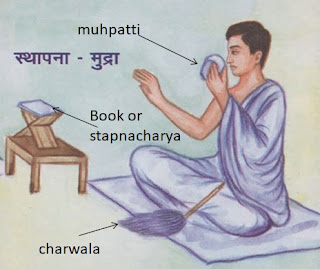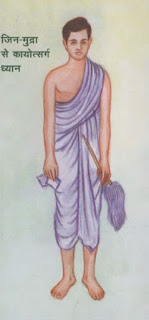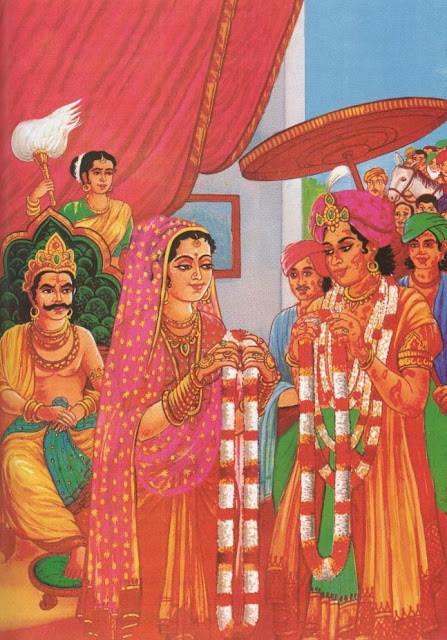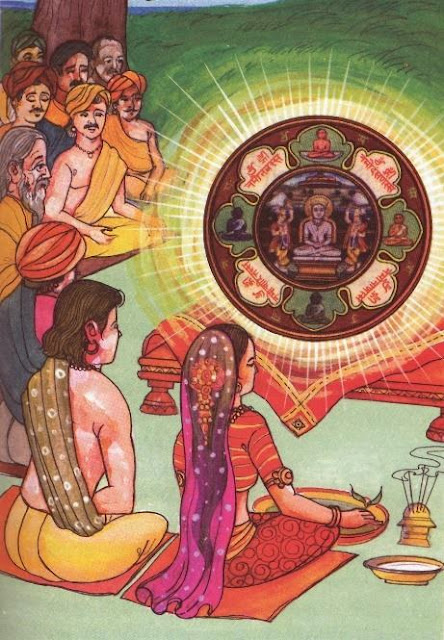ichchhämi khamäsamano ! vandium,
jävanijjäe nisihiyäe, matthaena vandämi.
Icchākārēṇa sandisaha bhagavan! Iriyāvahiyaṁ paḍikkamāmi? Icchaṁ.
Icchāmi paḍikkami'ūṁ. .1.
Iriyāvahiyā'ē virāhaṇā'ē.2.
Gamaṇāgamaṇē.3.
Pāṇa-kkamaṇē, bīya-kkamaṇē, hariya-kkamaṇē, ōsā-ūttiṅga-paṇaga-dagamaṭṭī-makkaḍā-santāṇā-saṅkamaṇē.4.
Jē mē jīvā virāhi'ā.5.
Ēgindiyā, bē'indiyā, tē'indiyā, ca'urindiyā, pan̄cindiyā.6.
Abhihayā, vattiyā, lēsiyā, saṅghā'iyā, saṅghaṭṭiyā, pariyāviyā, kilāmiyā, uddaviyā, ṭhāṇā'ō ṭhāṇaṁ saṅkāmiyā, jīviyā'ō vavarōviyā, tas'sa micchāmi dukkaḍaṁ.7.
tassa uttaree karanenan , paayachchhitt – karanenan , visohee – karanenan , visalleekaranenan , paavaanan kammaanan nigghaayanatthae thaami kaussaggan .1 . Annat'tha ūsasi'ēṇaṁ, nīsasi'ēṇaṁ khāsi'ēṇaṁ chī'ēṇaṁ jambhā'i'ēṇaṁ uḍḍu'ēṇaṁ vāyanisaggēṇaṁ bhamali'ē pittamucchā'ē.1.
Suhumēhiṁ aṅga san̄cālēhiṁ, suhumēhiṁ khēla san̄cālēhi, suhumēhi diṭṭhisan̄cālēhiṁ.2.
Ēvamā'i ēhiṁ āgārēhiṁ abhaggō avirāhi'ō hujja mē kā'us'saggō.3.
Jāva arihantāṇaṁ bhagavantāṇaṁ namukkārēṇaṁ na pārēmi.4 ||
Tāva kāyaṁ ṭhāṇēṇaṁ, mōṇēṇaṁ, jhāṇēṇaṁ, appāṇaṁ, vōsirāmi..5..
( chandesu nimmalayara tak ek logassaka
kausagg kare , logass nahee aata ho to chaar navakaar gine ) kausagg paarakar –Lōgas'sa ujjō'agarē, dham'matit'thayarē jiṇē. Arihantē kitta'is'saṁ, ca'uvīsaṁ pi kēvalī.1.
Usabhamaji'aṁ cha vandē, sambhavamabhiṇandaṇaṁ ca suma'iṁ ca. Pa'umappahaṁ supāsaṁ,
jiṇaṁ cha candappahaṁ vandē.2.
Sunvihiṁ ca pupphadantaṁ, sī'ala sijjansa vāsupūjjaṁ ca. Vimalamaṇantaṁ ca jiṇaṁ,
dham'maṁ santiṁ cha vandāmi.3.
Kunthuṁ araṁ ca malliṁ, vandē muṇisuvvayaṁ namijiṇaṁ ca vandāmi riṭhṭhanēmiṁ,
pāsaṁ taha vad'dhamāṇaṁ cha.4.
Ēvaṁ ma'ē abhithu'ā, vihuyarayamalā pahīṇajaramaṇā. Ca'uvīsaṁ pi jiṇavarā,
tit'thayarā mē pasīyantu.5. Kittiya vandiya mahiyā, jē ē lōgas'sa uttamā sid'dhā. Ārūgga bōhilābhaṁ, samāhivaramuttamaṁ dintu.6.
Candēsu nim'malayarā, ā'iccēsu ahiyaṁ payāsayarā. Sāgaravara – gambhīrā,
sid'dhā sid'dhiṁ mama disantu.7.
Icchāmi khamāsamaṇō! Vandi'ūṁ, jāvaṇijjā'ē
nisihi'ā'ē, mat'tha'ēṇa vandāmi
(Baiṭhakar bāyā ghūṭanā ūn̄cākara)
icchākārēṇa sandisaha bhagavan?
Caityavandana karūṁ? Icchaṁ.
Sakala kuśalavallīḥ puṣkarāvartamēghō,
duritatimirabhānuḥ kalpavr̥kṣōpamānaḥ
bhavajalanidhi – pōtaḥ sarvasampatti – hētu;
sa bhavatu satataṁ vaḥ, śrēyasē śāntināthaḥ śrēyasē pārśvanāthaḥ.
Jaya cintāmaṇī pārśvanātha jaya tribhuvana svāmī,
aṣṭakarma ripu jītīnē pan̄camī gati pāmī.1. Prabhu nāmē ānandakanda sukhasampatti lahīa̔ē,
prabhu nāmē bhavabhayataṇā pātika saba dahīa̔ē.2.
'Om hrīm̐ varṇa jōḍī karī japīa̔ē pārasa nāma,
viṣa amr̥ta tha'i pariṇamē pāmē avicala ṭhāma.3.
Jaṅkin̄ci nāma tit'thaṁ, saggē pāyāli māṇusē lō'ē. Jā'iṁ jiṇa-bimbā'iṁ,
tā'ī savvā'iṁ vandāmi. Namut'thuṇaṁ arihantāṇaṁ bhagavantāṇaṁ (1 )
ā'igarāṇaṁ tit'thayarāṇaṁ sayansambud'dhāṇaṁ (2 )
purisuttamāṇaṁ purisasihāṇaṁ purisavara – puṇḍarīyāṇaṁ purasavaragandhahat'thīṇaṁ (3 )
lōguttamāṇaṁ, lōganāhāṇaṁ, lōgahiyāṇaṁ, lōgapa'īvāṇaṁ, lōgapajjō'agarāṇaṁ (4 )
Abhayadayāṇaṁ cakkhudayāṇaṁ maggadayāṇaṁ saraṇadayāṇaṁ bōhidayāṇaṁ (5 )
dham'madayāṇaṁ dham'madēsayāṇaṁ dham'manāyagāṇaṁ dham'masārahīṇaṁ dham'mavaracā'urantacakkhavaṭṭīṇaṁ (6 )
appaḍi – haya-varanāṇadansaṇadharāṇaṁ vi'aṭṭacha'umāṇaṁ (7 )
jiṇāṇaṁ jāvayāṇaṁ tinnāṇaṁ tārayāṇaṁ bud'dhāṇaṁ bōhayāṇaṁ muttāṇaṁ mō'agāṇaṁ (8 )
Savvannūṇaṁ savvadarisiṇaṁ śivamayala-maru'a – maṇanta – makkhaya – mavvābāha – mapuṇarāvitti
sid'dhi ga'i nāmadhēyaṁ ṭhāṇaṁ sampattāṇaṁ namōjiṇāṇaṁ ji'abhayāṇaṁ (9 )
jē a a'īyā sid'dhā, jē a bhavis'santi ṇāga'ē kālē. Sampa'i a vaṭṭamāṇā, savvē tivihēṇa vandāmi (10)
(dō hātha jōḍakara)
Jaya vīyarāya! Jayaguru! Hō'u mamaṁ tuha pabhāva'ō bhayavaṁ
bhavanivva'ō maggāṇusāriyā iṭṭhaphala – sid'dhi 1
lōga – virud'dha – ccā'ō, gurujaṇa pū'ā parat'tha karaṇaṁ ca.
Suhaguru jōgō tavvayaṇa – sēvaṇā ābhavamakhaṇḍā.2
Icchāmi khamāsamaṇō! Vandi'ūṁ, jāvaṇijjā'ē nisihi'ā'ē, mat'tha'ēṇaṁ vandāmi.
Icchākārēṇa sandisaha bhagavan? Caityavandana karūṁ? Icchaṁ. Sid'dhāratha suta vandiyē,
triśalānō jāyō,
kṣatriyakuṇḍamā avataryō, sura narapati gāyō.1.
Mr̥gapati lan̄chana pā'ulē, sāta hāthanī kāya,
bahōtēra varṣanuṁ ā'ukhu, vīra jinēśvara rāya.2.
Khīmāvijaya jinarāyanō a̔ē, uttama guṇa avadāta,
sāta bōlathī varṇavyō padma vijaya vikhyāta.3.
Jaṅkin̄ci nāma tit'thaṁ saggē pāyāli māṇus'sē
lō'ē, jā'iṁ jiṇa bimbā'iṁ tā'iṁ savvā'iṁ vandāmi?
Namut'thuṇaṁ arihantāṇaṁ bhagavantāṇaṁ (1 )
ā'igarāṇaṁ tit'thayarāṇaṁ sayansambud'dhāṇaṁ (2 )
Purisuttamāṇaṁ purisasihāṇaṁ purisavara – puṇḍarīyāṇaṁ purisavaragandhahat'thīṇaṁ (3 )
lōguttamāṇaṁ, lōganāhāṇaṁ, lōgahiyāṇaṁ, lōgapa'īvāṇaṁ, lōgapajjō'agarāṇaṁ (4 )
ubhayadayāṇaṁ cakkhudayāṇaṁ maggadayāṇaṁ saraṇadayāṇaṁ bōhidayāṇaṁ (5 )
dham'madayāṇaṁ dham'madēsayāṇaṁ dham'manāyagāṇaṁ dham'masārahīṇaṁ dham'mavaracā – urantacakkhavaṭṭīṇaṁ (6 )
appaḍ'̔ihayavaranāṇa- dansaṇadharāṇaṁ vi'aṭṭhacha'umāṇaṁ (7 )
jiṇāṇaṁ jāvayāṇaṁ tinnāṇantārayāṇaṁ bud'dhāṇaṁ bōhayāṇaṁ muttāṇaṁ mō'agāṇaṁ (8 )
Savvanūṇaṁ savvadarisiṇaṁ śivamayala – maru'a – maṇanta makkhaya – mavvābāha – mapuṇarāvitti
sid'dhi ga'i nāmadhēyaṁ ṭhāṇaṁ sampattāṇaṁ namōjiṇāṇaṁ ji'abhayāṇaṁ (9 )
jē a a'īyā sid'dhā, jē a bhavis'santi ṇāga'ē kālē. Sampa'i vaṭṭamāṇā savvē tivihēṇa vandāmi (10)
(khaḍē hōkara)
arihanta cē'iyāṇaṁ
karēmi kā'usaggaṁ,
Vandaṇavattiyā'ē pū'aṇavattiyā'ē sakkāra-vattiyā'ē sam'māṇa vattiyā'ē, bōhilābhavattiyā'ē
niruvasaggavattiyā'ē, sad'dhā'ē, mēhā'ē, dhi'i'ē, dhāraṇā'ē aṇuppēhā'ē vaḍḍhamāṇi'ē, ṭhāmi kā'usaggaṁ.
Annat'tha ūsasi'ēṇaṁ, nīsasi'ēṇaṁ khāsi'ēṇaṁ chī'ēṇaṁ jambhā'ī'ēṇaṁ uḍḍua̔ēṇaṁ vāyanisaggēṇaṁ
bhamalī'ē pittamucchā'ē, suhumēhiṁ aṅgasan̄cālēhiṁ
Suhumēhiṁ khēla-san̄cālēhiṁ, suhumēhiṁ diṭṭhisan̄cālēhiṁ, ēvamā'i'ēhiṁ āgārēhiṁ abhaggō avirāhi'ō
hujja mē kā'us'saggō jāva arihantāṇaṁ bhagavantāṇaṁ namukkārēṇaṁ na pārēmi,
tāva kāyaṁ ṭhāṇēṇaṁ mōṇēṇaṁ jhāṇēṇaṁ appāṇaṁ vōsirāmi.
(Ēka navakāra kā kā'us'sagga pāra kara)
‘namō̕r'hat sid'dhācāryōpādhyāyasarvasādhubhyaḥ ‘
kahakara stuti kahē,
śaṅkhēśvara pārśvajī pūjī'ē, narabhavanō lāhō līji'ē,
manavān̄chita pūraṇa surataru, jaya vāmāsuta! Alavēsarūṁ.
lōgas'sa ujjō'agarē, dham'matit'thayarē jiṇē. Arihantē kitta'is'saṁ, ca'uvīsampi kēvalī. 1.
Usabhamaji'aṁ ca vandē, sambhavamabhiṇandaṇaṁ ca suma'iṁ ca, pa'umappahaṁ supāsa,
jiṇaṁ ca candappahaṁ vandē. 2.
Suvihiṁ ca pupfadantaṁ, sī'ala sijjansa vāsupūjjaṁ ca. Vimalamaṇantaṁ ca jiṇaṁ,
dham'maṁ santiṁ ca vandāmi. 3.
Kunthu araṁ ca malliṁ, vandē muṇisuvvayaṁ namijiṇaṁ ca vandāmi riṭṭhanēmiṁ,
pāsaṁ taha vad'dhamāṇaṁ ca, 4.
Ēvaṁ ma'ē abhithu'ā, vihuyarayamalā pahīṇajaramaṇā ca'uvīsaṁ pi jiṇavarā,
tit'thayarā mē pasīyantu. 5.
Kittiya vandiya mahiyā, jē ē lōgas'sa uttamā sid'dhā, ārūgga bōhilābhaṁ,
samāhivaramuttamaṁ dintu, 6.
Candēsu nim'malayarā, ā'iccēsu ahiyaṁ payāsayarā, sāgaravaragambhīrā,
sid'dhā sid'dhiṁ mama disantu. 7
Savvalō'ē arihanta cē'iyāṇaṁ karēmi kā'usaggaṁ, vandaṇa-vattiyā'ē pū'aṇavattiyā'ē
sakkāravattiyā'ē sam'māṇavattiyā'ē, bōhilābha-vattiyā'ē niruvasagga-vattiyā'ē,
sad'dhā'ē mēhā'ē dhi'i'ē dhāraṇā'ē aṇuppēhā'ē vaḍḍhamāṇi'ē ṭhāmi kā'us'saggaṁ.
Annat'tha ūsasia̔ēṇaṁ, nīsasia̔ēṇaṁ khāsi'ēṇaṁ chī'ēṇaṁ jambhā'ī'ēṇaṁ
uḍḍu'ēṇaṁ vāya-nisaggēṇaṁ bhamalī'ē pittamucchā'ē. Suhumēhiṁ aṅga san̄cālēhiṁ,
Suhumēhiṁ khēla-san̄cālēhiṁ, suhumēhiṁ diṭṭhisan̄cālēhiṁ, ēvamā'i'ēhiṁ,
āgārēhiṁ abhaggō avirāhi'ō hujja mē kā'us'saggō jāva arihantāṇaṁ bhagavantāṇaṁ
namukkārēṇaṁ na pārēmi, tāva kāyaṁ ṭhāṇēṇaṁ mōṇēṇaṁ jhāṇēṇaṁ appāṇaṁ vōsirāmi.
(Ēka navakāra kā kā'us'sagga pāra kara dūsarī stuti kahē)
dōya rātā jinavara atibhalā, dōya dhōḷā jinavara guṇanīlā,
dōya nīlā dōya śāmaḷa kahyā, sōḷē jina kan̄cana varṇa lahyā.
Pukkharavaradīvaḍḍhē, dhāya'īsaṇḍē a jambudīvē a, bharahēravaya vidēhē, dham'mā'igarē namansāmi.1
Tamatimira paḍala-vid'dhaṁ-saṇas'sa, suragaṇanarinda mahiyas'sa, sīmādharas'sa vandē,
papphōḍiya mōhajālas'sa. 2.
Jā'i-jarā maraṇa sōga paṇāsaṇas'sa, kallāṇa pukkhala visāla-suhā-vahas'sa,
kō dēva dāṇava-narindagaṇacci-yas'sa dham'mas'sa sāramuvalabbha karē pamāyaṁ. 3.
Sid'dhē bhō! Paya'ō ṇamō jiṇama'ē nandī sayā san̄jamē,
dēvaṁ-nāga-suvanna-kinnara gaṇa sabbhū'a-bhāvaccia̔ē, lōgō jat'tha pa'iṭṭhi'ō jagamiṇaṁ
tēlukkamaccāsuraṁ dham'mō vaḍḍhau sāsa'ō vijaya'ō dham'muttaraṁ vaḍḍha'u 4.
Su'as'sa, bhagava'ō karēmi kā'us'sagaṁ, vandaṇavattiyā'ē pū'aṇavattiyā'ē
sakkāra-vattiyā'ē sam'māṇa-vattiyā'ē bōhilābha vattiyā'ē niruvasagga-vattiyā'ē sad'dhā'ē mēhā'ē dhi'i'ē dhāraṇā'ē aṇuppēhā'ē vaḍḍhamāṇi'ē ṭhāmi kā'usaggaṁ.
Annat'tha ūsasia̔ēṇaṁ, nīsasia̔ēṇaṁ, khāsi'ēṇaṁ chī'ēṇaṁ jambhā'ī'ēṇaṁ uḍḍu'ēṇaṁ
vāya-nisaggēṇaṁ bhamalī'ē pittamucchā'ē. Suhumēhiṁ aṅga san̄cālēhiṁ,
suhumēhiṁ khēla-san̄cālēhiṁ, suhumēhiṁ diṭṭhisan̄cālēhi, ēvamā'i ēhiṁ āgārēhiṁ
abhaggō avirāhi'ō hujja mē kā'us'sagō jāva arihantāṇaṁ bhagavantāṇaṁ namukkārēṇaṁ na pārēmi,
tāva kāyaṁ ṭhāṇēṇaṁ mōṇēṇaṁ jhāṇēṇaṁ appāṇaṁ vōsirāmi.
(Ēka navakārakā kā'us'sagga pāra kara tīsarī stuti kahē)
āgama tē jinavara bhākhīyō gaṇadhara tē haiḍē rākhīyō,
tēhanō rasa jēṇē cākhīyō, tē huvō śivasukha sākhīyō.
Sid'dhāṇaṁ bud'dhāṇaṁ, pāra-gayāṇaṁ paramparagayāṇaṁ,
lō'aggamuva-gayāṇaṁ, namō sayā-savva-sid'dhāṇaṁ 1
jō dēvāṇa vi dēvō, jaṁ dēvā pan̄jali namansanti
taṁ dēvadēva-mahi'aṁ, sirasā vandē mahāvīraṁ 2
Ikkōvi namukkārō, jiṇavara-vasahas'sa vad'dhamāṇas'sa
sansāra sāgarā'ō tārē'i naraṁ vā nāriṁ vā 3
ujjinta sēla siharē, dikkhā-nāṇaṁ nisihi'ājas'sa,
taṁ dham'ma-cakkavaṭṭiṁ, ariṭṭhēnēmiṁ namansāmi 4
cattāri aṭṭha dasa dōya, vandi'ā jiṇavarā ca'uvvīsaṁ
paramaṭṭha-niṭṭhi-aṭṭhā, sid'dhā sid'dhiṁ mama disantu. 5.
Vēyāvaccagarāṇaṁ santigarāṇaṁ sam'madiṭṭhi-samāhigarāṇaṁ karēmi kā'us'sagaṁ.
Annat'tha ūsasia̔ēṇaṁ, nīsasia̔ēṇaṁ khāsi'ēṇaṁ chī'ēṇaṁ jambhā'ī'ēṇaṁ uḍḍa'ēṇaṁ
vāya-nisaggēṇaṁ bhamalī'ē pittamucchā'ē 1
suhumēhiṁ aṅga san̄cālēhiṁ, suhumēhiṁ khēlasan̄cālēhiṁ, suhumēhiṁ diṭṭhisan̄cālēhiṁ 2
ēvamā'i ēhiṁ āgārēhiṁ, abhaggō, avirāhi'ō, hujja mē kā'us'saggō 3
jāva arihantāṇaṁ bhagavantājaṁ. Namukkārēṇaṁ na pārēmi, 4
tāva kāyaṁ ṭhāṇēṇaṁ, mōṇēṇaṁ, jhāṇēṇaṁ, appāṇaṁ vōsirāmi.
(Ēka navakāra kā kā'us'sagga pāra kara)
‘namō̕r'hat sid'dhācāryōpādhyāyasarvasādhubhyaḥ ‘
dharaṇēndra rāya padmāvatī, prabhu pārśvataṇāṁ guṇa gāvatī,
sahu saṅghanāṁ saṅkaṭa cūratī, nayavimalanāṁ vān̄chita pūratī.
(Bāyā ghuṭanā ūn̄cā karakē)
Namut'thuṇaṁ arihantāṇaṁ bhagavantāṇaṁ 1
ā'igarāṇaṁ tit'thayarāṇaṁ sayansambud'dhāṇaṁ 2
purisuttamāṇaṁ purisasihāṇaṁ purisavara-puṇḍarīyāṇaṁ purisavaragandhahat'thīṇaṁ 3
lōguttamāṇaṁ, lōganāhāṇaṁ, lōgahiyāṇaṁ, lōgapa'īvāṇaṁ, lōgapajjō'agarāṇaṁ 4
abhayadayāṇaṁ cakkhudayāṇaṁ maggadayāṇaṁ saraṇadayāṇaṁ bōhidayāṇaṁ 5
Dham'madayāṇaṁ dham'madēsayāṇaṁ dham'manāyagāṇaṁ dham'masārahīṇaṁ dham'mavaracā'
urantacakkhavaṭṭīṇaṁ 6
appaḍ'̔ihaya- varanāṇadansaṇadharāṇaṁ vi'aṭṭhacha'umāṇaṁ 7
jiṇāṇaṁ jāvayāṇaṁ tinnāṇantārayāṇaṁ bud'dhāṇaṁ bōhayāṇaṁ muttāṇaṁ mō'agāṇaṁ 8
savvannūṇaṁ savvadarisiṇaṁ śivamayala-maru'a-maṇanta-makkhaya-mavvābāha-mapuṇarāvitti-sid'
dhiga'i nāmadhēyaṁ, ṭhāṇaṁ sampattāṇaṁ, namōjiṇāṇaṁ ji'abhayāṇaṁ 9
jē a a'īyā sid'dhā, jē a bhavis'santi ṇāga'ē kālē, sampa'i avaṭṭamāṇā, savvē tivihēṇa vandāmi 10
(Khaḍē hōkara)
arinhata cē'iyāṇaṁ karēmi kā'usaggaṁ,
vandaṇa-vattiyā'ē pū'aṇavattiyā'ē sakkāravattiyā'ē sam'māṇavattiyā'ē,
bōhilābhavattiyā'ē niruvasagga vattiyā'ē, sad'dhā'ē mēhā'ē dhi'i'ē dhāraṇā'ē
aṇuppēhā'ē vaḍḍhamāṇi'ē ṭhāmi kā'us'sagaṁ.
Annat'tha-ūsasi'ēṇaṁ, nīsasi'ēṇaṁ, khāsi'ēṇaṁ, chī'ēṇaṁ, jambhā'i'ēṇaṁ,
uḍḍu'ēṇaṁ, vāya-nisaggēṇaṁ, bhamalī'ē, pitta-mucchā'ē…………………. .1.
Suhumēhiṁ aṅga-san̄cālēhiṁ, suhumēhiṁ khēla-san̄cālēhiṁ,
suhumēhiṁ diṭṭhi-san̄cālēhiṁ. ……………………………………………. .2.
Ēvamā'i'ēhiṁ āgārēhiṁ, a-bhaggō a-virāhi'ō,
hujja mē kā'us'saggō. …………………………………………………. .3.
Jāva arihantāṇaṁ bhagavantāṇaṁ, namukkārēṇaṁ na pārēmi………….. .4.
Tāva kāyaṁ ṭhāṇēṇaṁ mōṇēṇaṁ jhāṇēṇaṁ, appāṇaṁ vōsirāmi………… .5.
(Ēka navakāra kā kā'us'saga pāra kara)
‘namō̕r'hat sid'dhācāryōpādhyāyasarvasādhubhyaḥ ‘
(kaha kara stuti kahē)
pāsa jiṇandā vāmānandā, jaba garabhē phaḷī,
supanāṁ dēkhē artha viśēṣē, kahē maghavā maḷī.
Lōgas'sa ujjō'a-garē, dham'ma-tit'tha-yarē jiṇē.
Arihantē kitta'is'saṁ, ca'uvīsaṁ pi kēvalī……………………………….. 1.
Usabha-maji'aṁ ca vandē, sambhava-mabhiṇandaṇaṁ ca suma'iṁ ca.
Pa'uma-ppahaṁ supāsaṁ, jiṇaṁ ca canda-ppahaṁ vandē…………………………….. 2.
Suvihiṁ ca puppha-dantaṁ, sī'ala-sijjansa-vāsu-pujjaṁ ca.
Vimala-maṇantaṁ ca jiṇaṁ, dham'maṁ santiṁ ca vandāmi……………………….. 3.
Kunthuṁ araṁ ca malliṁ, vandē muṇi-suvvayaṁ nami-jiṇaṁ ca.
Vandāmi riṭṭha-nēmiṁ, pāsaṁ taha vad'dhamāṇaṁ ca…………………………….. 4.
Ēvaṁ ma'ē abhithu'ā, vihuya-raya-malā pahīṇa-jara-maraṇā.
Ca'u-vīsaṁ pi jiṇavarā, tit'tha-yarā mē pasīyantu………………………. 5.
Kittiya-vandiya-mahiyā, jē ē lōgas'sa uttamā sid'dhā.
Ārugga-bōhi-lābhaṁ, samāhi-vara-muttamaṁ-dintu………………………….. 6.
Candēsu nim'mala-yarā, ā'iccēsu ahiyaṁ payāsa-yarā.
Sāgara-vara-gambhīrā, sid'dhā sid'dhiṁ mama disantu…………………………… 7.
Savvalō'ē arihanta cē'iyāṇaṁ karēmi kā'usaggaṁ, vandaṇa – vattiyā'ē pū'aṇavattiyā'ē
sakkāravattiyā'ē sam'māṇavattiyā'ē, bōhilābha-vattiyā'ē niruvasagga-vattiyā'ē,
sad'dhā'ē mēhā'ē dhi'i'ē dhāraṇā'ē aṇuppahā'ē vaḍḍhamāṇi'ē ṭhāmi kā'us'saggaṁ.
Annat'tha-ūsasi'ēṇaṁ, nīsasi'ēṇaṁ, khāsi'ēṇaṁ, chī'ēṇaṁ, jambhā'i'ēṇaṁ,
uḍḍu'ēṇaṁ, vāya-nisaggēṇaṁ, bhamalī'ē, pitta-mucchā'ē…………………. .1.
Suhumēhiṁ aṅga-san̄cālēhiṁ, suhumēhiṁ khēla-san̄cālēhiṁ,
suhumēhiṁ diṭṭhi-san̄cālēhiṁ. ……………………………………………. .2.
Ēvamā'i'ēhiṁ āgārēhiṁ, a-bhaggō a-virāhi'ō,
hujja mē kā'us'saggō. …………………………………………………. .3.
Jāva arihantāṇaṁ bhagavantāṇaṁ, namukkārēṇaṁ na pārēmi………….. .4.
Tāva kāyaṁ ṭhāṇēṇaṁ mōṇēṇaṁ jhāṇēṇaṁ, appāṇaṁ vōsirāmi………… .5.
( ek navakaar ka kaussaag paar kar doosaree stuti kahe )
veer ekaakee chaar hajaare , deeksha dhoore jinapati ,
paarshv ne malli trayashat saathe , beeja sahase vratee .
shatshat saathe sanyam dharata , vaasupoojy jagadhanee ,
anupam leela , gyaan raseela , dejo mune ghanee .2 .
( baad mein pukkharavakaddeevadde )
Pukkhara-vara-dīvaḍḍhē, dhāya'i-saṇḍē a jambu-dīvē a.
Bharahēravaya-vidēhē, dham'mā'i-garē namansāmi……………………………………………………………………. .1.
Tama-timira-paḍala-vid'dhaṁ-saṇas'sa sura-gaṇa-narinda-mahi'as'sa.
Sīmā-dharas'sa vandē, papphōḍi'a-mōha jālas'sa……………………………………………………………….. .2.
Jā'ī-jarā-maraṇa-sōga-paṇāsaṇas'sa,
kallāṇa-pukkhala-visāla-suhā-vahas'sa.
Kō dēva-dāṇava-narinda-gaṇa-cci'as'sa,
dham'mas'sa sāra-muvalabbha karē pamāyaṁ?……………………………………………………………………….. .3.
Sid'dhē bhō! Paya'ō ṇamō jiṇa-ma'ē nandī sayā san̄jamē,
dēvaṁ-nāga-suvanna-kinnara-gaṇa-sabbhū'a-bhāvacci'ē,
lōgō jat'tha pa'iṭṭhi'ō jagamiṇaṁ tēlukka-maccāsuraṁ,
dham'mō vaḍḍha'u sāsa'ō vijaya'ō dham'muttaraṁ vaḍḍha'u…………………………………………………………. .4.
Su'as'sa, bhagava'ō karēmi kā'us'saggaṁ
vandaṇavattiyā'ē pū'aṇattiyā'ē sakkāra-vattiyā'ē sam'māṇa-vattiyā'ē bōhilābha
vattiyā'ē niruvasagga-vattiyā'ē, sad'dhā'ē, mēhā'ē, dhi'i'ē, dhāraṇā'ē aṇuppēhā'ē
vaḍḍhamāṇi'ē, ṭhāmi kā'usaggaṁ.
Annat'tha-ūsasi'ēṇaṁ, nīsasi'ēṇaṁ, khāsi'ēṇaṁ, chī'ēṇaṁ, jambhā'i'ēṇaṁ,
uḍḍu'ēṇaṁ, vāya-nisaggēṇaṁ, bhamalī'ē, pitta-mucchā'ē…………………. .1.
Suhumēhiṁ aṅga-san̄cālēhiṁ, suhumēhiṁ khēla-san̄cālēhiṁ,
suhumēhiṁ diṭṭhi-san̄cālēhiṁ. ……………………………………………. .2.
Ēvamā'i'ēhiṁ āgārēhiṁ, a-bhaggō a-virāhi'ō,
hujja mē kā'us'saggō. …………………………………………………. .3.
Jāva arihantāṇaṁ bhagavantāṇaṁ, namukkārēṇaṁ na pārēmi………….. .4.
Tāva kāyaṁ ṭhāṇēṇaṁ mōṇēṇaṁ jhāṇēṇaṁ, appāṇaṁ vōsirāmi………… .5.
( ek navakaar ka kaussagg kar , paar kar teesaree stuti kahe . )
jinamukh deethee , vaanee meethee , surataru veladee ,
draaksh vihaase gaee vanavaase , peele ras seladee .
saakar sentee tarana letee , mukhe pashu chaavatee ,
amrt meethun svarge deethun , suravadhoo gaavatee .3 .
( baad mein siddhaanan buddhaanan kahe )
Sid'dhāṇaṁ bud'dhāṇaṁ,
pāragayāṇaṁ paramparagayāṇaṁ
lō'aggamuvagayāṇaṁ,
namō sayā savva sid'dhāṇaṁ……………1
jō dēvāṇa vi dēvō,
jaṁ dēvā pan̄jali namansanti,
taṁ dēva dēva mahi'aṁ,
sirasā vandē mahāvīraṁ……………….2
Ikkō vi namukkārō,
jiṇavara vasahas'sa vad'dhamāṇas'sa,
sansāra sāgarā'ō, tārē'i naraṁ vā nāriṁ vā……….3
Ujjinta sēla siharē,
dikkhā nāṇaṁ nisīhi'ā jas'sa:
Taṁ dham'macakkavaṭṭiṁ
ariṭṭhanēmiṁ nammasāmi………………….4
Cattāri aṭṭha dasa dōya,
vandiyā jiṇavarā ca'uvvīsaṁ,
paramaṭṭha niṭṭhi aṭṭhā,
sid'dhā sid'dhiṁ mama disantu……..5
Vēyāvaccagarāṇaṁ santigarāṇaṁ sam'madiṭṭhi-samāhigarāṇaṁ karēmi kā'us'sagaṁ.
Annat'tha-ūsasi'ēṇaṁ, nīsasi'ēṇaṁ, khāsi'ēṇaṁ, chī'ēṇaṁ, jambhā'i'ēṇaṁ,
uḍḍu'ēṇaṁ, vāya-nisaggēṇaṁ, bhamalī'ē, pitta-mucchā'ē…………………. .1.
Suhumēhiṁ aṅga-san̄cālēhiṁ, suhumēhiṁ khēla-san̄cālēhiṁ,
suhumēhiṁ diṭṭhi-san̄cālēhiṁ. ……………………………………………. .2.
Ēvamā'i'ēhiṁ āgārēhiṁ, a-bhaggō a-virāhi'ō,
hujja mē kā'us'saggō. …………………………………………………. .3.
Jāva arihantāṇaṁ bhagavantāṇaṁ, namukkārēṇaṁ na pārēmi………….. .4.
Tāva kāyaṁ ṭhāṇēṇaṁ mōṇēṇaṁ jhāṇēṇaṁ, appāṇaṁ vōsirāmi………… .5.
(Ēka navakāra kā kā'us'sāga pāra kara)
‘namō̕r'hat sid'dhācāryōpādhyāyasarvasādhubhyaḥ ‘
Gajamukha daśē vāmana yakṣō mastakē phaṇāvalī,
cāra tē bāhī kacchapavāhī kāyā jasa śāmalī.
Ca'ukara prauḍhā nāgāruḍhā dēvī padmāvatī,
sōvana kānti prabhuguṇa gātī vīra gharē āvatī.4.
(Bāyā ghuṭanā ūn̄cā karakē namut'thuṇaṁ kahē)
Namut'thuṇaṁ, arihantāṇaṁ, bhagavantāṇaṁ…………………………………….. .1.
Ā'i-garāṇaṁ, tit'tha-yarāṇaṁ, sayaṁ-sambud'dhāṇaṁ…………………………….. .2.
Purisuttamāṇaṁ, purisa-sīhāṇaṁ, purisa-vara-puṇḍarī'āṇaṁ,
purisa-vara-gandha-hat'thīṇaṁ………………………………………………….. .3.
Lōguttamāṇaṁ, lōga-nāhāṇaṁ, lōga-hi'āṇaṁ,
lōga-pa'īvāṇaṁ, lōga-pajjō'a-garāṇaṁ…………………………………… .4.
Abhaya-dayāṇaṁ, cakkhu-dayāṇaṁ, magga-dayāṇaṁ,
saraṇa-dayāṇaṁ, bōhi-dayāṇaṁ………………………………………………. .5.
Dham'ma-dayāṇaṁ, dham'ma-dēsayāṇaṁ, dham'ma-nāyagāṇaṁ,
dham'ma-sārahīṇaṁ, dham'ma-vara-cā'uranta-cakkavaṭṭīṇaṁ…………………… .6.
Appaḍ'̔ihaya-vara-nāṇa-dansaṇa-dharāṇaṁ, viyaṭṭa-cha'umāṇaṁ……………… .7.
Jiṇāṇaṁ, jāvayāṇaṁ, tinnāṇaṁ, tārayāṇaṁ, bud'dhāṇaṁ,
bōhayāṇaṁ, muttāṇaṁ, mō'agāṇaṁ…………………………………………….. .8.
Savvannūṇaṁ, savva-darisīṇaṁ, siva-mayala-maru'a-maṇanta-
makkhaya-mavvābāha-mapuṇarāvitti sid'dhiga'i-nāmadhēyaṁ
ṭhāṇaṁ sampattāṇaṁ, namō jiṇāṇaṁ, ji'a-bhayāṇaṁ………………………….. .9.
Jē a a'īyā sid'dhā, jē a bhavis'santi-ṇāga'ē kālē.
Sampa'i a vaṭṭamāṇā, savvē ti-vihēṇa vandāmi…………………………. .10.
Jāvanti cē'i'ā'iṁ, uḍḍē a ahē a tiri'a lō'ē a,
savvā'iṁ tā'iṁ vandē
iha santō tat'tha santā'iṁ. ………….1
Icchāmi khamāsamaṇō! Vandi'ūṁ, jāvaṇijjā'ē nisihi'ā'ē, mat'tha'ēṇaṁ vandāmi.
Jāvanta kē vi sāhū,
bharahēravaya mahāvidēhē a,
savvēsiṁ tēsiṁ pāṇa'ō,
tivihēṇa tidaṇḍa virayāṇaṁ……….1
namorhat siddhaachaaryopaadhyaayasarvasaadhubhyah .
( pustak mein se stavan bolen )
( stavan ke baad uvasaggaharan sootr bolo )
Uvasaggaharaṁ pāsaṁ, pāsaṁ vandāmi kam'ma-ghaṇa mukkaṁ.
Visahara visa ninnāsaṁ, maṅgala kallāṇa āvāsaṁ..1..
Visahara phuliṅga mantaṁ, kaṇṭhē dhārē'i jō sayā maṇu'ō.
Tas'sa gaha rōga mārī, duṭṭha jarā janti uvasāmaṁ..2..
Ciṭṭha'u durē mantō, tujjha paṇāmō vi bahu phalō hō'i.
Naratiri'ēsu vi jīvā, pāvanti na dukkha-dōgaccaṁ..3..
Tuha sam'mattē lad'dhē, cintāmaṇi kappapāya vabbhahi'ē.
Pāvanti avigghēṇaṁ, jīvā ayarāmaraṁ ṭhāṇaṁ..4..
I'a santhu'ō mahāyasa, bhattibbhara nibbharēṇa hi'a'ēṇa.
Tā dēva dijja bōhiṁ, bhavē bhavē pāsa jiṇacanda..5..
(Hātha jōḍakara muktāsukti mudrā mēṁ)
jaya vīyarāya! Jagaguru! Hō'u mama tuha pabhāva'ō bhayavaṁ!
Bhavanivva'ō maggā-ṇusāriyā iṭṭhaphalasid'dhi.1.
Lōgavirūd'dhaccā'ō, gurujaṇa pū'ā parat'tha karaṇaṁ ca.
Suhaguru jōgō tavvayaṇa-sēvaṇā ābhavamakhaṇḍā. 2
Icchāmi khamāsamaṇō! Vandi'ūṁ, jāvaṇijjā'ē nisihi'ā'ē, mat'tha'ēṇaṁ vandāmi.
Icchākārēṇa sandisaha bhagavan? Caityavandana karūṁ? Iccha.
padmaprabhune vaasupoojy , doy raata kahiye ,
chandraprabh ne suvidhinaath , do ujjval lahie .1 .
mallinaath ne paarshvanaath , doy neela neerakhya ,
munisuvrat ne neminaath , doy anjan sareekha .2 .
sole jin kanchan samae , eva jin choveesh ,
dheeravimal pandit tano , gyaanavimal kahe shishy .3 .
jankinchi naam titthan , sagge paayaali maanuse loe . jain jin – bimbain , taee savvain vandaami .1 .
Namut'thuṇaṁ, arihantāṇaṁ, bhagavantāṇaṁ…………………………………….. .1.
Ā'i-garāṇaṁ, tit'tha-yarāṇaṁ, sayaṁ-sambud'dhāṇaṁ…………………………….. .2.
Purisuttamāṇaṁ, purisa-sīhāṇaṁ, purisa-vara-puṇḍarī'āṇaṁ,
purisa-vara-gandha-hat'thīṇaṁ………………………………………………….. .3.
Lōguttamāṇaṁ, lōga-nāhāṇaṁ, lōga-hi'āṇaṁ,
lōga-pa'īvāṇaṁ, lōga-pajjō'a-garāṇaṁ…………………………………… .4.
Abhaya-dayāṇaṁ, cakkhu-dayāṇaṁ, magga-dayāṇaṁ,
saraṇa-dayāṇaṁ, bōhi-dayāṇaṁ………………………………………………. .5.
Dham'ma-dayāṇaṁ, dham'ma-dēsayāṇaṁ, dham'ma-nāyagāṇaṁ,
dham'ma-sārahīṇaṁ, dham'ma-vara-cā'uranta-cakkavaṭṭīṇaṁ…………………… .6.
Appaḍ'̔ihaya-vara-nāṇa-dansaṇa-dharāṇaṁ, viyaṭṭa-cha'umāṇaṁ……………… .7.
Jiṇāṇaṁ, jāvayāṇaṁ, tinnāṇaṁ, tārayāṇaṁ, bud'dhāṇaṁ,
bōhayāṇaṁ, muttāṇaṁ, mō'agāṇaṁ…………………………………………….. .8.
Savvannūṇaṁ, savva-darisīṇaṁ, siva-mayala-maru'a-maṇanta-
makkhaya-mavvābāha-mapuṇarāvitti sid'dhiga'i-nāmadhēyaṁ
ṭhāṇaṁ sampattāṇaṁ, namō jiṇāṇaṁ, ji'a-bhayāṇaṁ………………………….. .9.
Jē a a'īyā sid'dhā, jē a bhavis'santi-ṇāga'ē kālē.
Sampa'i a vaṭṭamāṇā, savvē ti-vihēṇa vandāmi…………………………. .10.
(Muktāśukti mudrā mēṁ hātha jōḍakara)
jaya vīyarāya! Jagaguru! Hō'u mama tuha pabhāva'ō bhayavaṁ!
Bhavanivvē'ō maggā-ṇusāriyā iṭṭhaphalasid'dhi.1.
Lōgavirūd'dhaccā'ō, gurujaṇa pū'ā parat'tha karaṇaṁ ca.
Suhaguru jōgō tavvayaṇa-sēvaṇā ābhavamakhaṇḍā. 2
(Hātha nīcē kara)
vārijja'i ja'i vi niyāṇabandhaṇaṁ vīyarāya! Tuha samayē tahavi mama hujja sēvā,
bhavē bhavē tumha calaṇāṇaṁ. Dukkhakkha'ō, kam'makkha'ō, samāhimaraṇaṁ ca bōhilābhō a.
Sampajja'u maha ē'aṁ, tuha nāha paṇāma karaṇēṇaṁ
sarvamaṅgala-māṅgalyaṁ, sarva kalyāṇa-kāraṇaṁ,
pradhānaṁ sarvadharmāṇāṁ, jainaṁ jayati śāsanam.
Icchāmi khamāsamaṇō vandi'uṁ jāvaṇijjāa̔ē nisīhi'āa̔ē mat'thaa̔ēṇa vandāmi.
(Avidhi āśātanā micchāmi dukkaḍam. )
Dēvavandana samāpta
kṣudrōpadrava upaśama kā'usagga khamā.
Icchākārēṇa sandisaha bhagavan kṣudrōpadrava upaśamanārthaṁ kā'usagga karūṁ? Icchaṁ kṣudrō.
Karēmi kā'u. Annat'tha.
(1 Navakāra, sampūrṇa lōgas'sa, uvasaggaharaṁ na āyē tō tēraha navakāra kā kā'usagga)
namō̕r'hat- “sarvē yajñāmbikādyā yē, vaiyāvr̥tyakarā jinē.
Kṣudrōpadravasaṅghātaṁ tē drutaṁ drāvayantu naḥ. “
Prakaṭa lōgassa








 Gochari (Alm)
Gochari (Alm) Vihar
Vihar Loch
Loch
